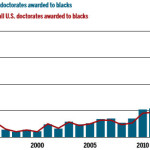CHEYENNE, Wyo. (AP) _ Wyoming is becoming more ethnically diverse as minorities account for most of the state’s population growth, according to new census data.
The data show Wyoming’s minority population _ defined as any group other than single-race non-Hispanic whites _ grew by 17 percent from 2010 to July 2013, accounting for 13,444 people, Wenlin Liu, principal economist with the Wyoming Economic Analysis Division, said.
By comparison, the state’s overall population grew by 3.4 percent over the same period with minorities accounting for two-thirds of that growth.
Hispanics make up the largest minority group in the state, increasing 12.2 percent from 2010 to 2013 to a population of 56,363.
The black population more than doubled over the same period to 9,182; the Asian, Pacific Islander and multiracial populations also rose by 15 percent or more.
Wyoming’s non-Hispanic white population rose just 1.2 percent.
But due to their prior demographic advantages, whites still make up 84.1 percent of the total population.
Liu said the reason the minority population is growing faster in Wyoming is because of such things as immigration, internal migration and a higher overall birth rate.
“It’s not only Wyoming; it’s a national trend,” Liu told the Wyoming Tribune Eagle (http://bit.ly/THP62M). “For the U.S. as a whole, you can see the non-Hispanic white population only increased 3.1 percent from 2012 to 2013.”
One advantage to that, he said, is that young minorities and their high birth rates are helping to keep Wyoming’s median age below the U.S. average.
Between 2010 and 2013, Wyoming’s median age stayed unchanged at 36.8; the U.S. median rose from 37.2 to 37.6.
Liu said positive net migration to Wyoming also helped to keep the median age lower. Younger people are more likely to migrate for work, and that has been the biggest driver of migration to the state.
“Any time we have population moving here, it’s a group of relatively young people,” Liu said. “Wyoming’s migration is mostly employment based, so it’s different from people moving to Arizona or Florida to retire.”
But he said that while Wyoming’s median age may be below the U.S. average, the 65-and-over population is rising faster than the U.S. average.
As Baby Boomers begin entering retirement age, there may not be enough younger workers to replace them, even with current migration trends, Liu said.
“If it continues, we could have a labor shortage,” he said.
But Dick O’Gara, who heads the Wyoming Center for Business & Economic Analysis, said he is not as worried about the potential for a labor shortage, even if the state does get grayer.
O’Gara said that while energy booms have brought influxes of younger workers, it remains to be seen whether that trend is sustainable.
In addition, employers can keep older workers longer, improve worker efficiency or use various incentives to attract new workers, O’Gara said.











